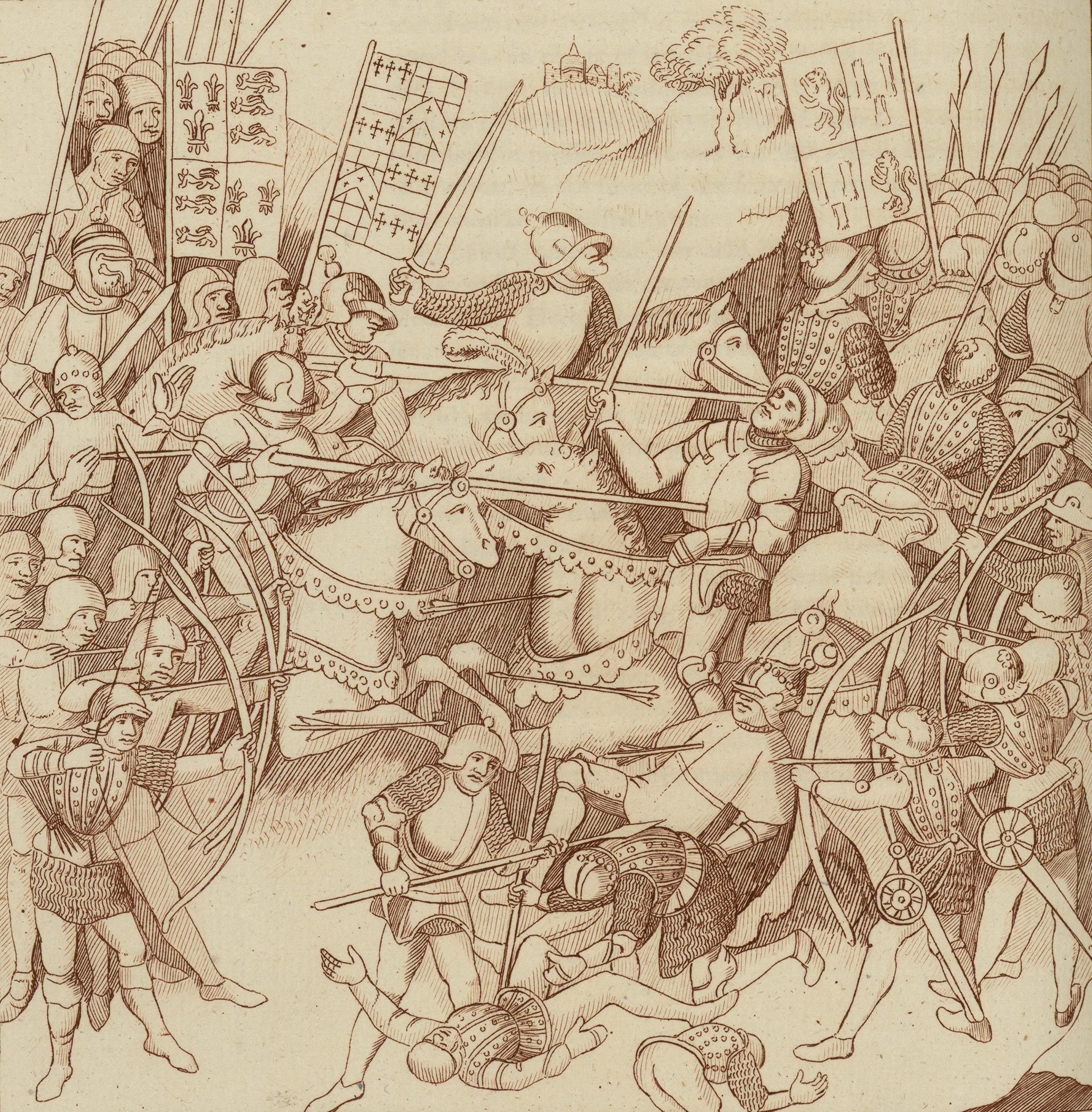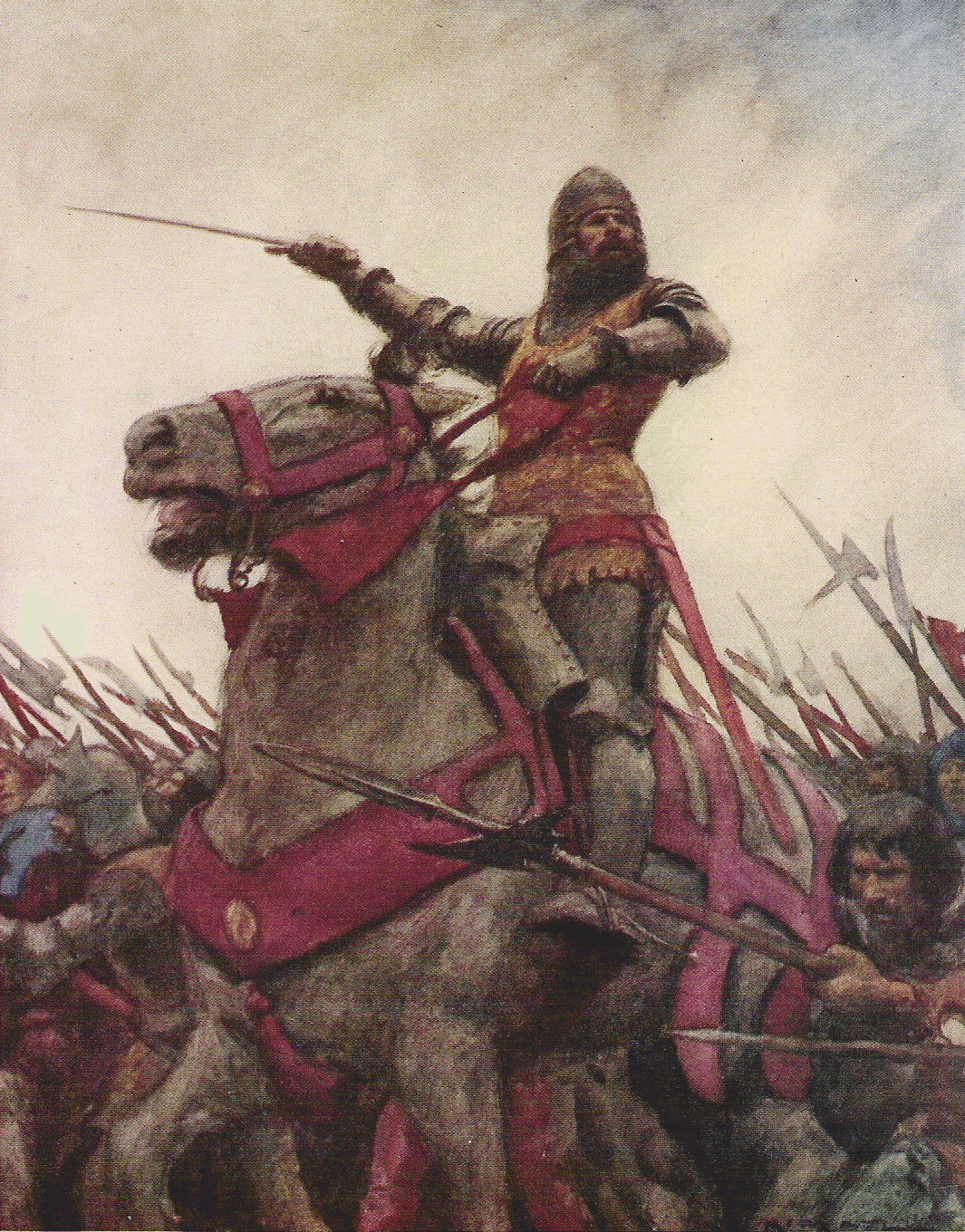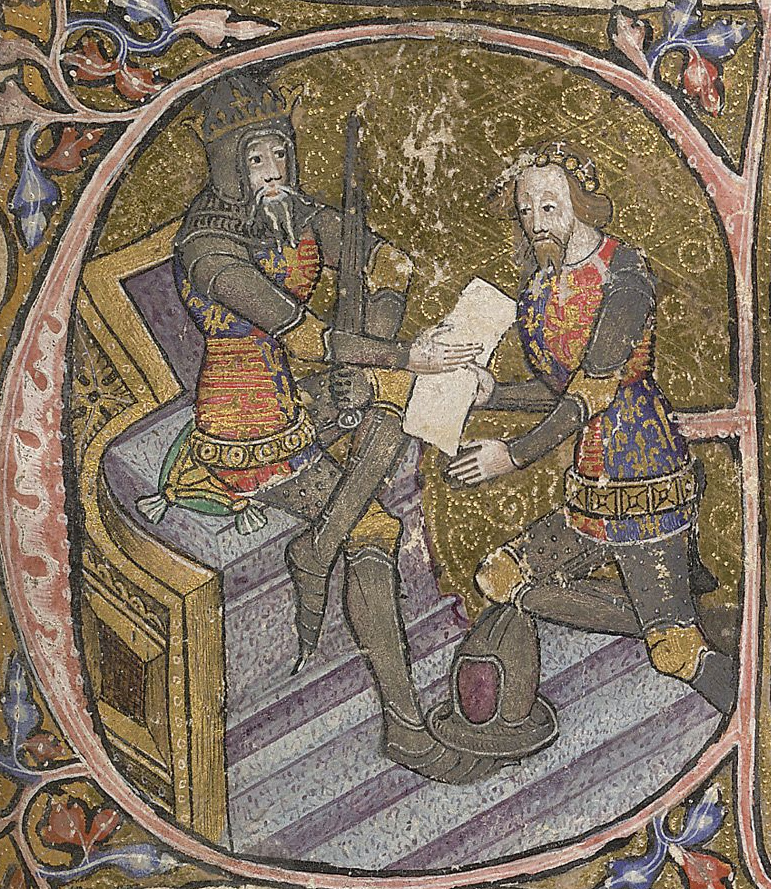|
Richard De Beauchamp, 13th Earl Of Warwick
Richard Beauchamp, 13th Earl of Warwick (25 or 28 January 138230 April 1439) was an English medieval nobleman and military commander. Early life Beauchamp was born at Salwarpe Court Richard Gough, ''Description of the Beauchamp chapel, adjoining to the church of St. Mary, at Warwick. And the monuments of the earls of Warwick, in the said church and elsewhere'' (Warwick Town, St Mary, 1803)p. 17/ref> in Salwarpe, Worcestershire, the son of Thomas de Beauchamp, 12th Earl of Warwick and Margaret Ferrers, a daughter of William Ferrers, 3rd Baron Ferrers of Groby. His godfather was King Richard II of England. He was knighted at the coronation of King Henry IV, and succeeded as Earl of Warwick in 1401. Welsh rebellion Soon after reaching his majority and taking responsibility for the Earldom, he saw military action in Wales, defending against a Welsh rebellion led by Owain Glyndŵr. On 22 July 1403, the day after the Battle of Shrewsbury, he was made a Knight of the Garter. ... [...More Info...] [...Related Items...] OR: [Wikipedia] [Google] [Baidu] |
Henry VI Of England
Henry VI (6 December 1421 – 21 May 1471) was King of England from 1422 to 1461 and 1470 to 1471, and English claims to the French throne, disputed King of France from 1422 to 1453. The only child of Henry V of England, Henry V, he succeeded to the Throne of England, English throne at the age of eight months, upon his father's death, and to the List of French monarchs, French throne on the death of his maternal grandfather, Charles VI of France, Charles VI, shortly afterwards. Henry was born during the Hundred Years' War (1337–1453), he is the only English monarch to have been crowned King of France, following his coronation at Notre-Dame de Paris in 1431 as Henry II. His early reign, when England was ruled by a Regency government, 1422–1437, regency government, saw the pinnacle of English power in Kingdom of France, France. However, setbacks followed once he assumed full control in 1437. The young king faced military reversals in France, as well as political and financia ... [...More Info...] [...Related Items...] OR: [Wikipedia] [Google] [Baidu] |
Crickhowell
Crickhowell (; , non-standard spelling ') is a town and community (Wales), community in southeastern Powys, Wales, near Abergavenny, and is in the historic counties of Wales, historic county of Brecknockshire. Location The town lies on the River Usk, on the southern edge of the Black Mountains, Wales, Black Mountains and in the eastern part of the Brecon Beacons National Park. Significant parts of the surrounding countryside, over , form part of the Glanusk Park estate. Etymology and language The name Crickhowell is an anglicised spelling that corresponds to the Welsh language, Welsh Crucywel. The name is derived from Crug Hywel, meaning 'Hywel's mound'. This is usually identified with the Iron Age hill fort on nearby Table Mountain, although this has the local name of Mynydd y Begwn. It may be that Crug Hywel refers to the castle mound in the town itself. The language of Crickhowell (and Llangynidr) was originally Welsh. In his 1893 book ''Wales and her language'', John E ... [...More Info...] [...Related Items...] OR: [Wikipedia] [Google] [Baidu] |
Tretower Castle
Tretower Castle () is a Grade I-listed ruined castle in the village of Tretower in the county of Powys, Wales. It was built around the beginning of the twelfth century as a motte and bailey castle and this was probably replaced mid-century by a stone shell keep. The castle was enlarged in the early thirteenth century, but later fell into ruin. History Tretower (Dictionary of the Placenames of Wales byHywel Wyn owen and Richard Morgan; Gomer Press, 2007) was founded as a motte and bailey castle by Picard, a follower of Bernard de Neufmarché. Probably around 1150, Picard's son, Roger Picard I, replaced the motte with a shell keep. By about 1230 a tall cylindrical keep was added to the inside of the shell keep, possibly by his great-grandson, Roger Picard II, and the space between was roofed over. At this time the earlier bailey was walled in stone and provided with cylindrical corner towers. In the early 14th century residential buildings were constructed away from the original ... [...More Info...] [...Related Items...] OR: [Wikipedia] [Google] [Baidu] |
Monmouthshire
Monmouthshire ( ; ) is a Principal areas of Wales, county in the South East Wales, south east of Wales. It borders Powys to the north; the English counties of Herefordshire and Gloucestershire to the north and east; the Severn Estuary to the south, and Torfaen, Newport, Wales, Newport and Blaenau Gwent to the west. The largest town is Abergavenny, and the administrative centre is Usk. The county is administered by Monmouthshire County Council. It sends two directly-elected members to the Senedd at Cardiff and one elected member to the Parliament of the United Kingdom, UK parliament at Westminster. The county name is identical to that of the Monmouthshire (historic), historic county, of which the current local authority covers the eastern three-fifths. Between 1974 and 1996, the county was known as Gwent (county), Gwent, recalling Kingdom of Gwent, the medieval kingdom which covered a similar area. The present county was formed under the Local Government (Wales) Act 1994, which ... [...More Info...] [...Related Items...] OR: [Wikipedia] [Google] [Baidu] |
Knight Of The Garter
The Most Noble Order of the Garter is an order of chivalry founded by Edward III of England in 1348. The most senior order of knighthood in the Orders, decorations, and medals of the United Kingdom, British honours system, it is outranked in United Kingdom order of precedence, precedence only by the Award, decorations of the Victoria Cross and the George Cross. The Order of the Garter is dedicated to the image and Coat of arms, arms of Saint George, England's patron saint. Appointments are at the Monarchy of the United Kingdom, Sovereign's sole discretion, typically made in recognition of national contribution, service to the Crown, or for distinguished personal service to the Monarch. Membership of the order is limited to the sovereign, the Prince of Wales, and no more than 24 living members, or Companions. The order also includes Supernumerary Knights and Ladies (e.g., members of the British royal family and foreign monarchs). The order's emblem is a garter (stockings), gar ... [...More Info...] [...Related Items...] OR: [Wikipedia] [Google] [Baidu] |
Battle Of Shrewsbury
The Battle of Shrewsbury was fought on 21 July 1403, waged between an army led by the Lancastrian King Henry IV and a rebel army led by Henry "Harry Hotspur" Percy from Northumberland. The battle, the first in which English archers fought each other on English soil, reaffirmed the effectiveness of the longbow and ended the Percy challenge to King Henry IV of England. Part of the fighting is believed to have taken place at what is now Battlefield, Shropshire, England, three miles (5 km) north of the centre of Shrewsbury. It is marked today by Battlefield Church and Battlefield Heritage Park. Background The Percys had previously supported Henry IV in a war against King Richard II of England, which ended when Henry IV took the throne in 1399. The Percys subsequently supported Henry IV in Wales, early in the rebellion of Owain Glyndŵr, and in Scotland, in both negotiations with and conflict against the Scots. King Henry IV had been supported by a number of wealthy land ... [...More Info...] [...Related Items...] OR: [Wikipedia] [Google] [Baidu] |
Owain Glyndŵr
Owain ap Gruffydd (28 May 135420 September 1415), commonly known as Owain Glyndŵr (Glyn Dŵr, , anglicised as Owen Glendower) was a Welsh people, Welsh leader, soldier and military commander in the Wales in the late Middle Ages, late Middle Ages, who led a Glyndŵr rebellion, 15-year-long Welsh revolt with the aim of ending Kingdom of England, English rule in Wales. He was an educated lawyer, forming the first Welsh parliament under his rule, and was the last native-born Welshman to claim the title Prince of Wales. During the year 1400, Glyndŵr, a Welsh soldier and Glyndyfrdwy, Lord of Glyndyfrdwy had a dispute with a neighbouring Peerage of England, English Lord, the event which spiraled into a national revolt pitted common Welsh countrymen and nobles against the English military. In response to the rebellion, discriminatory Penal laws against the Welsh, penal laws were implemented against the Welsh people; this deepened civil unrest and significantly increased support for ... [...More Info...] [...Related Items...] OR: [Wikipedia] [Google] [Baidu] |
Welsh People
The Welsh () are an ethnic group and nation native to Wales who share a common ancestry, History of Wales, history and Culture of Wales, culture. Wales is one of the four countries of the United Kingdom. The majority of people living in Wales are British nationality law, British citizens. In Wales, the Welsh language () is protected by law. Welsh remains the predominant language in many parts of Wales, particularly in North Wales and parts of West Wales, though English is the predominant language in South Wales. The Welsh language is also taught in schools in Wales; and, even in regions of Wales in which Welsh people predominantly speak English on a daily basis, the Welsh language is spoken at home among family or in informal settings, with Welsh speakers often engaging in code-switching and translanguaging. In the English-speaking areas of Wales, many Welsh people are Multilingualism, bilingually fluent or semi-fluent in the Welsh language or, to varying degrees, capable o ... [...More Info...] [...Related Items...] OR: [Wikipedia] [Google] [Baidu] |
Wales
Wales ( ) is a Countries of the United Kingdom, country that is part of the United Kingdom. It is bordered by the Irish Sea to the north and west, England to the England–Wales border, east, the Bristol Channel to the south, and the Celtic Sea to the south-west. , it had a population of 3.2 million. It has a total area of and over of Coastline of Wales, coastline. It is largely mountainous with its higher peaks in the north and central areas, including Snowdon (), its highest summit. The country lies within the Temperate climate, north temperate zone and has a changeable, Oceanic climate, maritime climate. Its capital and largest city is Cardiff. A distinct Culture of Wales, Welsh culture emerged among the Celtic Britons after the End of Roman rule in Britain, Roman withdrawal from Britain in the 5th century, and Wales was briefly united under Gruffudd ap Llywelyn in 1055. After over 200 years of war, the Conquest of Wales by Edward I, conquest of Wales by King Edward I o ... [...More Info...] [...Related Items...] OR: [Wikipedia] [Google] [Baidu] |
Henry IV Of England
Henry IV ( – 20 March 1413), also known as Henry Bolingbroke, was King of England from 1399 to 1413. Henry was the son of John of Gaunt, Duke of Lancaster (a son of King Edward III), and Blanche of Lancaster. Henry was involved in the 1388 revolt of Lords Appellant against Richard II, his first cousin, but he was not punished. However, he was exiled from court in 1398. After Henry's father died in 1399, Richard blocked Henry's inheritance of his father's lands. That year, Henry rallied a group of supporters, overthrew and imprisoned Richard II, and usurped the throne; these actions later contributed to dynastic disputes in the Wars of the Roses (1455–1487). Henry was the first English ruler whose mother tongue was English (rather than French) since the Norman Conquest, over 300 years earlier. As king, he faced a number of rebellions, most seriously those of Owain Glyndŵr, the last Welshman to claim the title of Prince of Wales, and the English knight Henry Percy (Hotspur) ... [...More Info...] [...Related Items...] OR: [Wikipedia] [Google] [Baidu] |
Richard II Of England
Richard II (6 January 1367 – ), also known as Richard of Bordeaux, was King of England from 1377 until he was deposed in 1399. He was the son of Edward the Black Prince, Edward, Prince of Wales (later known as the Black Prince), and Joan, Countess of Kent. Richard's father died in 1376, leaving Richard as List of heirs to the English throne, heir apparent to his grandfather, King Edward III; upon the latter's death, the 10-year-old Richard succeeded to the throne. During Richard's first years as king, government was in the hands of a series of regency councils, influenced by Richard's uncles John of Gaunt and Thomas of Woodstock. England at that time faced various problems, most notably the Hundred Years' War. A major challenge of the reign was the Peasants' Revolt in 1381, and the young king played a central part in the successful suppression of this crisis. Less warlike than either his father or grandfather, he sought to bring an end to the Hundred Years' War. A firm ... [...More Info...] [...Related Items...] OR: [Wikipedia] [Google] [Baidu] |








